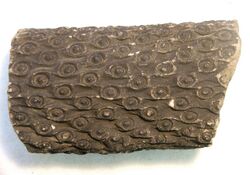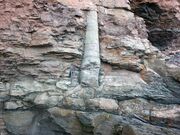Biology:Stigmaria
| Stigmaria | |
|---|---|

| |
| Stigmaria, a fossil lycopsid rhizome | |
| Scientific classification | |
| Kingdom: | Plantae |
| Clade: | Tracheophytes |
| Clade: | Lycophytes |
| Class: | Lycopodiopsida |
| Order: | †Lepidodendrales |
| Genus: | †Stigmaria Brongn. |
Stigmaria is a form taxon for common fossils found in Carboniferous rocks.[1] They represent the underground rooting structures of arborescent lycophytes such as Sigillaria and Lepidodendron under the order Lepidodendrales.
Description and morphology

Overview
The Paleozoic swamps had tree-like lycopsids that grew up to 30 m (98 ft),[2] and even 50 m (160 ft) in height.[3] These lycopsid plants were anchored by an extensive network of branching underground structures with root-like appendages attached to them. The underground organs or structures of these lycopsids is referred to as Stigmaria.[4] Lycopsids first evolved during a rapid diversification of terrestrial land plants in the Devonian period[5] and became common plants within the Carboniferous coal forest flora. Lycopsids grew in low-level swampy wetland areas which they flourished during the Pennsylvanian age.[6] [7] Analysis of the morphology and anatomy of the stigmarian systems suggests that the axes around the structure were shoot-like, and so they are called rhizomes or rhizomorphs.[8] In general, common species of Stigmaria (Stigmaria ficoides sp.) have been analyzed extensively to provide an understanding of its morphology and histology.[4]
Appendages ("rootlets")
The stigmarian systems had rhizomorph axes that presented circular scars around the rhizomorph apices of Stigmaria species, where the root-like appendages were attached to the circular scars. These appendages were branched dichotomously, meaning that there were multiple orders of branching functionality to comprise areas of the stigmarian system. Since the stigmarian systems were root-like, these lateral appendages indicate that these were modified leaves adapted to serve the function of the stigmarian system. Stigmaria had a complex branching structure; therefore, it is comparable to the rhizomes of the extant (living) relative, the quillworts (genus Isoetes). The stigmarian system extends leaning from the foundation of the stem as four proximal axes, leading to a hollow rooting structure.[8]

Along the rhizomorph axes, the appendages are linked to each axis in a circular pattern and would shed during the growth stage, forming the circular scars of Stigmaria. The lateral appendages have a circular layout, and the growth abscission is more distinctive of leaves than present lateral roots. The four proximal axes dichotomize, creating a long underground system ranging up to 15 m (49 ft) in radius, while being up to 40 cm (16 in) long and 0.5–1 cm (0.20–0.39 in) wide. The stigmarian rootlets vary in size and do not dichotomize as they move further away from the central points of the axes. In terms of the position, each stigmarian rootlet has a vascular strand monarch which is surrounded by a condensed inner cortex. Externally, this inner cortex consists of a thin outer cortex and hollow middle cortex, and a network enlarges from the inner cortex to the outer cortex.[9]
Endarch is defined as the primary xylem of Stigmaria, and organized in forked vascular strands encompassed by vascular cambium. Tracheids of the secondary xylem are formed in spiral lines and consist of scalariform wall thickenings, while the fimbrils are similar to those in the aerial branches. The tracheids uniform to the stigmarian rhizomorph axes did not form vascular cambium, but dense meristem.[10]
Development

Stigmaria development is linked to the changes in aerial stems found in typical rhizomic structures seen in present plants. Stigmaria's features are unrelated (in functionality) when linking to the functions of present plant roots and rhizomes. Moreover, the spiral structure of the stigmarian rootlet attachment is distinct to the unsymmetrical adjustment of roots and rhizomes typically seen in modern plants. While there were lateral appendages in Stigmaria, none were found in the root systems of modern plants. However, fungi has mycorrhizae, which are functioned from cortical parenchyma cells.[11]
Though vascular bundles in leaves are bilaterally symmetrical including the appendages of Stigmaria and the monarch vascular bundle, present rhizomes have a radial point of symmetric vascular tissues. Furthermore, within a certain growth stage, foliar abscission (active shedding) of the appendages occurs from the stigmarian axis. Nonetheless, root abscission is relatively absent in modern plants. The stigmarian rootlets indicate that there is a similarity in the Lepidodendrales aerial structure system, and carries support to its stability features including absorbent organs, branching, and forking of proximal sectors of the axis. The linkage to the Lepidodendrales vascular plants proposes that the development and changes of the aerial shoot system including the stems existed among stigmarian systems.[12]
Since many lycopsids from the Paleozoic had a height of up to 50 m (160 ft) meters, and grew in unsteady engulfed and saturated soil, the lycopods and their stigmarian system grew around the river systems.[3][13] Therefore, it is debatable to how the underground system could handle the plants. Evidence to support their height was compared to the extensive stigmarian system. Thus, it may be that the progression of the rhizomorph axes appeared to have secondary growth in their growth stages of the cortex. They may have been preferred to stand upright since arborescent lycopyhtes had bushy branches and only a few secondary xylem. The branches of neighboring lycopsids could interweave and deliver foundational support to the base stem.[11] On the other hand, the branch density and development of the wood in present trees can prevent uprooting.[14]
Gallery
-
Bedding plane view of a flattened Stigmaria preserved atop a shallow-water carbonaceous limestone. Joggins, Nova Scotia, Canada.
-
In situ Stigmaria fossil from the Joggins Formation (Pennsylvanian), Cumberland Basin, Nova Scotia, Canada
-
In situ lycopsid with attached stigmarian system from Joggins, Nova Scotia, Canada
-
Stigmaria impression with visible rootlets connecting from the rhizome
References
- ↑ Rothwell, GW; Erwin, DM (1985). "The rhizophore apex of Paurodendron: implications for homologies among the rooting organs of Lycopsida". American Journal of Botany 72: 86–98. doi:10.2307/2443571.
- ↑ Wang, Deming; Qin, Min; Lu, Le; Liu, Lu; Zhou, Yi; Zhang, Yingyang; Huang, Pu; Xue, Jinzhuang et al. (8 August 2019). "The Most Extensive Devonian Fossil Forest with Small Lycopsid Trees Bearing the Earliest Stigmarian Roots". Current Biology 29: 2604-2615. doi:10.1016/j.cub.2019.06.053. https://www.sciencedirect.com/science/article/pii/S0960982219307808. Retrieved 13 January 2024.
- ↑ 3.0 3.1 V. V. Alekhin (1961). Geografiia rastenii s osnovani botaniki (Geography of plants and basics of botany). Gos. nauchno-pedagog. izd-vo. p. 167. https://books.google.com/books?id=OUIPAQAAMAAJ&q=лепидодендроны. Retrieved 2020-10-05.
- ↑ 4.0 4.1 Williamson, William Crawford (1887). A monograph on the morphology and histology of Stigmaria ficoides. 40. Palaeontographical society. https://books.google.com/books?id=KDBPAAAAYAAJ&q=Williamson+,+W.+C.+1887+b+.+A+monograph+on+the+morphology+and+histology+of+Stigmaria+fi+coides+.+Palaeontological+Society+Monographs+40+:+1+%E2%80%93+62+.+%5B9%5D+&pg=PA5.
- ↑ Xu, Hong-He; Yang, Ning; Bai, Jiao; Wang, Yao; Liu, Feng; Ouyang, Shu (1 February 2022). "Palynological assemblage of the Lower Devonian of Hezhang, Guizhou, southwestern China". Review of Palaeobotany and Palynology 297: 104561. doi:10.1016/j.revpalbo.2021.104561. ISSN 0034-6667. https://www.sciencedirect.com/science/article/pii/S0034666721001858. Retrieved 25 November 2023.
- ↑ Cleal, C. J. & Thomas, B. A. (2005). "Palaeozoic tropical rainforests and their effect on global climates: is the past the key to the present?" Geobiology, 3, p. 13-31.
- ↑ Christopher J. Cleal; Barry A.Thomas (1994). Plant Fossils of the British Coal Measures. The Palaeontological Association. ISBN 0-901702-53-6.
- ↑ 8.0 8.1 Hetherington, AJ; Berry, CM; Dolan, Liam (June 14, 2016). "Networks of highly branched stigmarian rootlets developed on the first giant trees". PNAS 113 (24): 6695–6700. doi:10.1073/pnas.1514427113. PMID 27226309. PMC 4914198. http://www.pnas.org/content/113/24/6695.full.pdf?with-ds=yes. Retrieved 15 February 2017.
- ↑ Weiss, Frederick Ernest (1902). "The Vascular branches of Stigmarian rootlets". Annals of Botany (JSTOR) 16 (63): 559–573.
- ↑ Rothwell, Gar W.; Pryor, Janelle S. (1991). "Developmental dynamics of arborescent lycophytes—apical and lateral growth in Stigmaria ficoides". American Journal of Botany (iley Online Library) 78 (12): 1740–1745. doi:10.1002/j.1537-2197.1991.tb14538.x.
- ↑ 11.0 11.1 Niklas, Karl J. (1992). Plant biomechanics: an engineering approach to plant form and function. University of Chicago press. ISBN 9780226586311. https://books.google.com/books?id=l3bRJVMbNMcC&pg=PR9.
- ↑ Frankenberg, Julian M.; Eggert, Donald A. (1969). "Petrified Stigmaria from North America: Part I. Stigmaria ficoides, the underground portions of Lepidodendraceae". Palaeontographica Abteilung B (Schweizerbart'sche Verlagsbuchhandlung): 1–47.
- ↑ Davies, N.S.; Gibling, M. R. (2011). "Evolution of fixed-channel alluvial plains in response to Carboniferous vegetation". Nature Geoscience 21 (9): 629–633. doi:10.1038/ngeo1237. Bibcode: 2011NatGe...4..629D.
- ↑ Šamonil, Pavel; Král, Kamil; Hort, Libor (2010). "The role of tree uprooting in soil formation: A critical literature review". Geoderma (Elsevier BV) 157 (3-4): 65–79. doi:10.1016/j.geoderma.2010.03.018. ISSN 0016-7061.
Wikidata ☰ Q2277036 entry
 |





